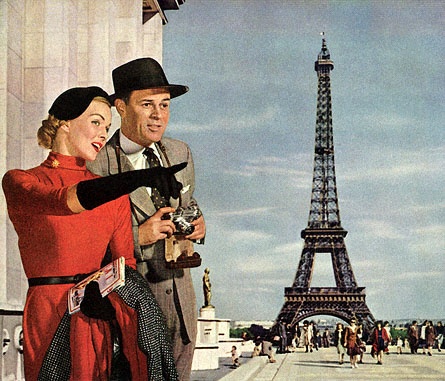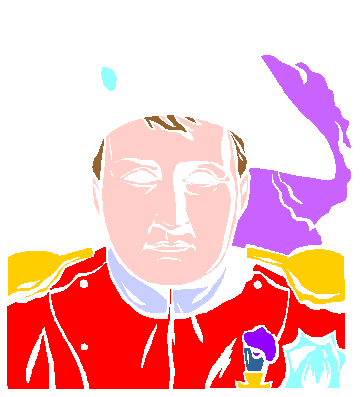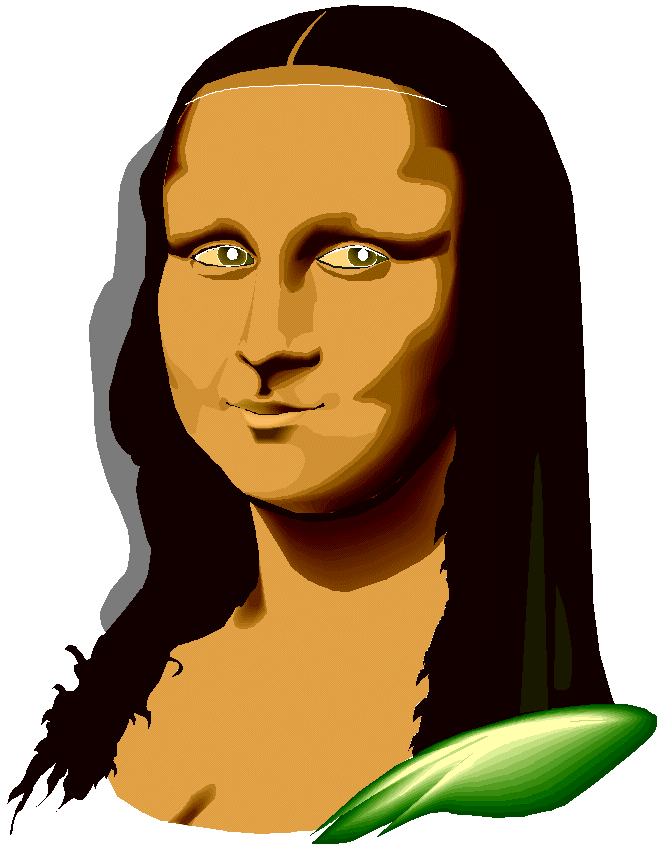

The Celts were the first advanced culture to occupy the area we now call France. Caesar conquered the Celts around 52 BC. The Romans called the area Gaul (which generally corresponds to modern France) and ruled 500 years until overrun by Clovis I, king of the Germanic Franks, in 486.
France became part of a vast empire ruled by Charlemagne (Charles I), King of the Franks, who was also crowned Emperor of the Romans in St. Peter's Basilica on Christmas Day, 800 AD. Many historians mark that date as the beginning of the Holy Roman Empire. On Charlemagne's death, his empire was divided among his three sons, and France emerged as one of the successor kingdoms. Charlemagne's ancestral line ended in 986 with the death of Louis V (the Sluggard), and for the next few centuries France was engaged in various wars particularly with the English.
During the Hundred Years War (1338-1453), much of France was occupied by the English. Late in the war, a young girl named Jehanne la Pucelle, or Joan of Arc, who claimed she was directed by heavenly voices, led the French to victory at Orleans and Patay (1429). Two years later, however, she fell into the hands of the English and was burned at the stake in Rouen for "sorcery and witchcraft." Nevertheless, France eventually regained most of the territories it had lost to the English and by the late 1600s dominated most of Europe.
Louis XIV, known as the Sun King for the splendor of his court at Versailles, ruled for 72 years and was succeeded by his great-grandson. His palace at Versailles was the envy of Europe but also a symbol of the monarchy's extravagance. That, and some costly losses in war, gave rise to the French Revolution.
The French Revolution of 1789 began on the tennis courts at Versailles when the "Third Estate" (peasants) declared themselves the government. When Louis XVI and Marie Antoinette were guillotined, other European monarchs declared war on France. Although founded on good intentions ("Liberty, Equality, and Fraternity"), early reversals in the war and economic problems led to a reactionary period known as the Reign of Terror. The Reign of Terror, led by Robespierre, claimed over 17,000 victims before cooler (and intact) heads prevailed and Robespierre himself went to the guillotine. After several years of chaos and corruption, an artillery officer, Napoleon Bonaparte, took control of affairs as chief "consul."
 Napoleon declared himself Emperor (in a classic Roman
ceremony) in Notre Dame cathedral in 1804. During his short rule, he conquered
and remapped much of Europe and put a final end to the so-called Holy Roman
Empire (1806). However, he could not conquer Admiral Nelson's navy nor the
frigid vastness of Russia. Nelson destroyed Napoleon's fleet at Trafalgar,
and half a million soldiers of the Grande Armee perished in the march
on Moscow (or more accurately, the march back from Moscow). In 1814, Austrian
and Prussian forces occupied much of France and exiled Napoleon to the isle
of Elba. But Napoleon returned from Elba in 1815 and was not finally
defeated until the Battle of Waterloo (Belgium ,1815). He died of cancer
in exile on the Island of St. Helena in 1821. The monarchy was restored
which was followed by the Second Republic and then the Second Empire.
Napoleon declared himself Emperor (in a classic Roman
ceremony) in Notre Dame cathedral in 1804. During his short rule, he conquered
and remapped much of Europe and put a final end to the so-called Holy Roman
Empire (1806). However, he could not conquer Admiral Nelson's navy nor the
frigid vastness of Russia. Nelson destroyed Napoleon's fleet at Trafalgar,
and half a million soldiers of the Grande Armee perished in the march
on Moscow (or more accurately, the march back from Moscow). In 1814, Austrian
and Prussian forces occupied much of France and exiled Napoleon to the isle
of Elba. But Napoleon returned from Elba in 1815 and was not finally
defeated until the Battle of Waterloo (Belgium ,1815). He died of cancer
in exile on the Island of St. Helena in 1821. The monarchy was restored
which was followed by the Second Republic and then the Second Empire.
Louis XVII, son of Louis XVI and Marie Antoinette, died in prison and never ruled.
Louis XVIII, brother of Louis XVI, was crowned king in 1814, but this Bourbon restoration ended when Charles X was deposed by the July Revolution of 1830. Louis Philippe, who succeeded Charles X, was himself overthrown in the February Revolution of 1848. He was the last French king.
Napoleon II (Francois), son of Napoleon and Marie Louise, never ruled. Louis Napoleon Bonaparte, nephew of Napoleon, became President in 1848 and Emperor as Napoleon III in 1852. When Napoleon III mismanaged and lost the Franco-Prussian war, he was deposed (1870). Napoleon III was the last emperor (unless, like some others, you count DeGaulle).
 The Louvre began with the art collection of
Francis I which included the Mona Lisa (La Jaconde). Today, the Louvre boasts
over 400,000 pieces of art, but "only" 20,000 or so are on display.
Obviously, there are too many famous works to mention,
but try at least to see Winged Victory and Venus de Milo as well as the
Mona Lisa. Works of Impressionists, by the way, are in the Jeu de Paume
museum, not the Louvre.
The Louvre began with the art collection of
Francis I which included the Mona Lisa (La Jaconde). Today, the Louvre boasts
over 400,000 pieces of art, but "only" 20,000 or so are on display.
Obviously, there are too many famous works to mention,
but try at least to see Winged Victory and Venus de Milo as well as the
Mona Lisa. Works of Impressionists, by the way, are in the Jeu de Paume
museum, not the Louvre.
The Arc de Triomphe is located at the intersection of 12 avenues
 including the Champs Elysees. The arch commemorates Napoleon's victories
in the same tradition as Rome commemorated its great leaders (such as Constantine's
Arch). Begun in 1806, it is the largest triumphal arch in the world.
including the Champs Elysees. The arch commemorates Napoleon's victories
in the same tradition as Rome commemorated its great leaders (such as Constantine's
Arch). Begun in 1806, it is the largest triumphal arch in the world.
The Place de la Concorde, best known as the site of the guillotine during the Revolution, is also the site of an Egyptian obelisk from the temple of Rameses in Luxor that dates back to 1300 BC.
Notre Dame is a magnificent cathedral located on the Ile de la Cite. It incorporates Early Gothic styling inside and High Gothic in the exterior design. Its most characteristic exterior feature is its flying buttresses. The cathedral took more than 150 years to build. Pope Alexander III laid the cornerstone in 1163. During the Revolution, the peasants cut the heads off all the statues.
The Bastille, a prison fortress, was a symbol of royal power. It was stormed and taken by the people on 14 July 1789 which is still celebrated as Bastille Day. But don't look for the Bastille. All that remains is a line on the ground.
The Dome des Invalides, a church and military hospital built by Louis XIV, is Napoleon's burial place. His body was brought back to France in 1840 and buried here. His tomb consists of seven separate sarcophagi the outermost sarcophagus being made of rare red marble.
The Conciergerie was an administrative center and a prison during the Reign of Terror that held those waiting for the guillotine including Marie Antoinette and Robespierre.
The Panthenon was built by Louis XV and is
a shrine to, and burial site for, famous Frenchmen. St. Genevieve, patron
saint of France, was buried here as well as Victor Hugo, Emile Zola, Rousseau,
Voltaire, and Louis Braille.
The Moulin Rouge (Red Windmill) was the favorite hangout of Toulouse-Lautrec, the most famous of poster artists. It is also known as the birthplace of the Can-Can.
 The Eiffel Tower, designed by Gustave Eiffel
in 1889 (who also designed the Statue of Liberty), was meant to be dismantled
20 years after its construction, but became a symbol of Paris and was left
intact for us to enjoy. It is approximately 1000 feet high. You can dine
on top at the Jules Verne restaurant.
The Eiffel Tower, designed by Gustave Eiffel
in 1889 (who also designed the Statue of Liberty), was meant to be dismantled
20 years after its construction, but became a symbol of Paris and was left
intact for us to enjoy. It is approximately 1000 feet high. You can dine
on top at the Jules Verne restaurant.
Over a period of 50 years, Versailles was transformed from a small hunting lodge to the grandest palace in Europe. To build Versailles it was necessary to move hills, fill in swamps, and reroute a river. The palace included 1500 fountains, a thousand orange trees (set in silver pots), a zoo for exotic animals, canals complete with Venetian gondolas, serenading musicians, and the famous Hall of Mirrors. Most rooms were guilded in gold and decorated in fine silk and tapestries. You gotta see it for yourself.